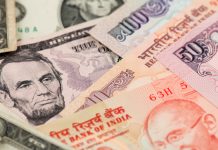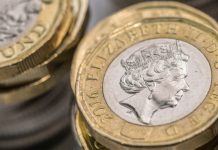The pound US dollar exchange rate dropped by 1% across the previous week as no deal Brexit fears returned to haunt investors. Despite last week’s heavy loss, the pound US dollar managed to finish the month of August flat, after dropping over 4% in July. The pound is pushing higher in early trade on Monday.
| What do these figures mean? |
| When measuring the value of a pair of currencies, one set equals 1 unit and the other shows the current equivalent. As the market moves, the amount will vary from minute to minute.
For example, it could be written: 1 GBP = 1.28934 USD Here, £1 is equivalent to approximately $1.29. This specifically measures the pound’s worth against the dollar. If the US dollar amount increases in this pairing, it’s positive for the pound. Or, if you were looking at it the other way around: 1 USD = 0.77786 GBP In this example, $1 is equivalent to approximately £0.78. This measures the US dollar’s worth versus the British pound. If the sterling number gets larger, it’s good news for the dollar. |
The pound declined versus the dollar last week amid growing fears that a no deal Brexit is becoming the most probable outcome on 31st October when the UK leaves the European Union. The probability of a no deal Brexit jumped Prime Minister Boris Johnson acquired permission from the Queen to suspend Parliament for an uncharacteristically long period of over a month prior to the Queen’s speech. The proroguing of Parliament from 9th September until 14th October will frustrate pro- Remainers efforts to prevent a no deal Brexit.
With so few days between Parliament returning from summer recess and Parliament being suspended, ministers opposing Boris Johnsons plans will need to act quickly. Whilst it will be challenging to push a bill through parliament preventing a no deal Brexit in such a short space of time, it is not impossible. A vote of no confidence in the government is also possible. This could result in further political uncertainty and potentially a general election.
There are a few data points which could attract some attention across the week, such as manufacturing, construction and service sector pmi’s. However, it will be Brexit headlines that will be the central focus driving the pound.
| Why is a “soft” Brexit better for sterling than a “hard” Brexit? |
| A soft Brexit implies anything less than UK’s complete withdrawal from the EU. For example, it could mean the UK retains some form of membership to the European Union single market in exchange for some free movement of people, i.e. immigration. This is considered more positive than a “hard” Brexit, which is a full severance from the EU. The reason “soft” is considered more pound-friendly is because the economic impact would be lower. If there is less negative impact on the economy, foreign investors will continue to invest in the UK. As investment requires local currency, this increased demand for the pound then boosts its value. |
Fed Talk & US — Sino Trade Headlines To Drive Dollar
The dollar advanced versus the pound in the previous week, despite US GDP slipping lower. Instead investors cheered developments in the US — Sino trade dispute. President Trump claimed that Chia was ready for a trade deal. China also confirmed that it would not retaliate immediately against US tariffs on Chinese imports which started 1st September. Trade tensions will remain in focus, with investors watching headlines carefully. Given the negative impact that the US — Sino trade dispute is having on areas of the US economy, market participants view an easing of tensions as beneficial for the US economy, reducing the prospect of stimulus from the Federal Reserve.
Investors will also pay close attention to Federal Reserve policy makers speeches this week for further clues as to the next steps by the Fed. Any signs that the Fed are leaning more in favour of rate cut as the US economy starts to show signs of slowing, could bring the dollar lower.
| Why do raised interest rates boost a currency’s value? |
| Interest rates are key to understanding exchange rate movements. Those who have large sums of money to invest want the highest return on their investments. Higher interest rate environments tend to offer higher yields. So, if the interest rate or at least the interest rate expectation of a country is relatively higher compared to another, then it attracts more foreign capital investment. Large corporations and investors need local currency to invest. More local currency used then boosts the demand of that currency, pushing the value higher. |
Currencylive.com is a site operated by TransferWise Inc. (“We”, “Us”), a Delaware Corporation.
The content on our site is provided for general information only. It is not intended to amount to advice on which you should rely. You must obtain professional or specialist advice before taking, or retain from, any action on the basis of the content on our site.
Although we make reasonable efforts to update the information on our site, we make no representations, warranties or guarantees, whether express or implied, that the content on our site is accurate, complete or up to date. Some of the content posted on this site has been commissioned by Us, but is the work of independent contractors. These contractors are not employees, workers, agents or partners of TransferWise and they do not hold themselves out as one. The information and content posted by these independent contractors have not been verified or approved by Us. The views expressed by these independent contractors on currencylive.com do not represent our views





